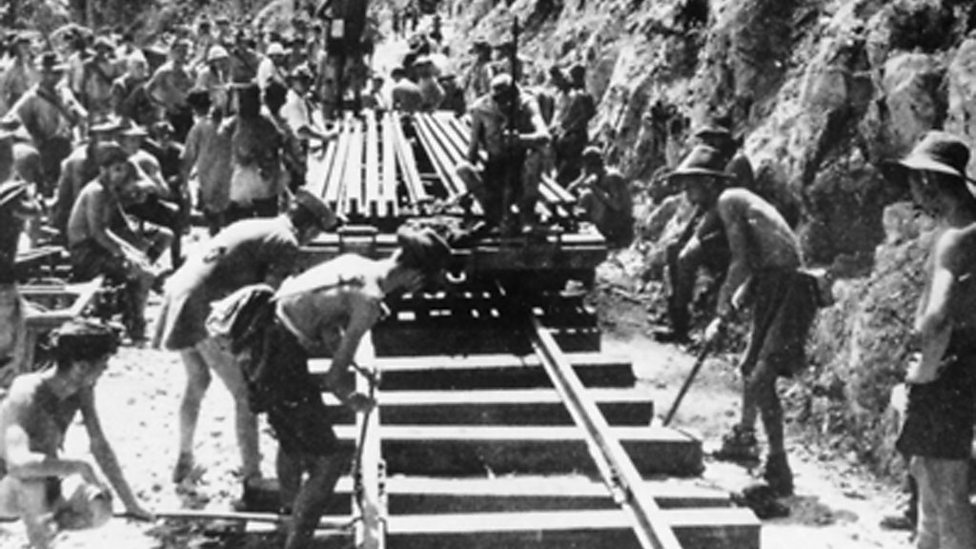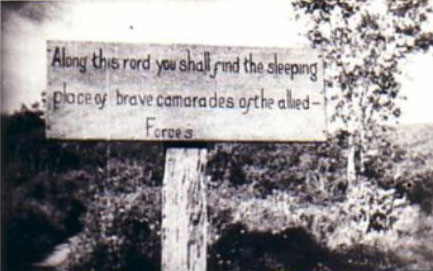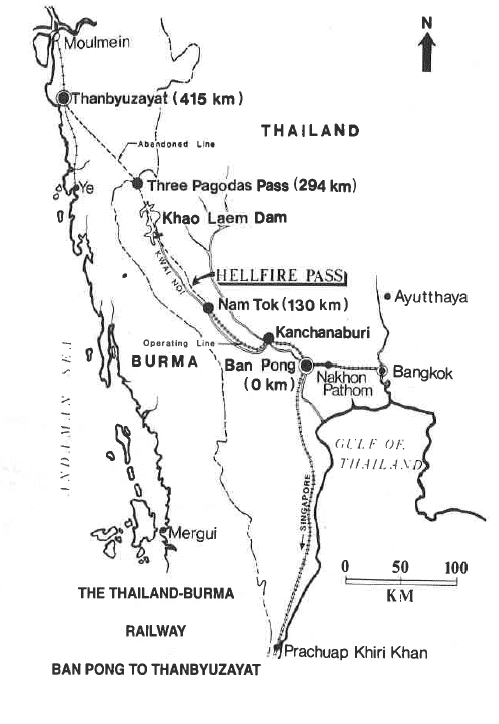

Brought up by barge on the Kwai Noi river, or by lorry on a road which was merely a converted jungle track, a consistent service could not be maintained by either method, and rations were nearly always below even the Japanese official scales. Throughout the building of the railway, food supplies were irregular and totally inadequate. Railway Construction Camp - Kanya, Thailand Frequently men were sent to work on the line long before their accommodation was completed. The cook-house and huts for the working parties came next and accommodation for the sick last of all. Accommodation for the Japanese guards had to be built first, and at all the staging camps built subsequently along the railway this rule applied. Two forces, one based in Thailand and one in Burma, worked from opposite ends' of the line towards the centre.When the first of the prisoners arrived their initial task was the construction of camps at Kanchanaburi and Ban Pong in Thailand and Thanbyuzayat in Burma. From June 1942 onwards large groups of prisoners were transferred periodically to Thailand and Burma from Java, Sumatra and Borneo. They utilised a labour force composed of prisoners of war taken in the campaigns in South-East Asia and the Pacific, and coolies brought from Malaya and the Dutch East Indies or conscripted in Siam and Burma. More than 250 miles of railway, from Thanbyuzayat in Burma to Ban Pong in Thailand, remained to be constructed, much of it through mountainous country and dense jungle, in a region with one of the worst climates in the world.The Japanese aimed at completing the railway in 14 months, or at least by the end of l943. The decision to complete the railway connecting Moulmein with Bangkok, which had been commenced before the war but abandoned by the two countries concerned, was taken in June 1942. It is open to general traffic from Ban Pong to Kanchanaburi, about 33 miles.Japanese communications depended upon a long and exposed sea route to Rangoon via Singapore and the Strait of Malacca, and a road (quite unfit for prolonged heavy traffic) from Raheng through Kowkarelk to Moulmein. The railway has been purchased by the Thai Government from its starting point at Ban Pong to the Burmese border, and it is now part of the Royal State railways.

The Japanese kept no records and it was impossible for anyone else to do so, nor were the graves marked, but between 80,000 and 100,000 perished. Imprest Burmese and Malay labourers too died in their thousands - exactly how many will never be known. During its construction more than 16 ,000 prisoners of war died - mainly of sickness, malnutrition and exhaustion - and were buried along the railway. The construction of the 420-kilometre railway between Ban Pong in Thailand and Thanbyuzayat in Burma led to the deaths of 2,700 Australians, and more than 12,000 Allied soldiers.The notorious Burma-Siam railway, built by British, Australian, Dutch and American prisoners of war, was a Japanese project inspired by the need for improved communications to maintain the large Japanese Armv in Burma. How many soldiers died on the Burma railway? The cutting soon became a site of memory for many Australians, particularly on Anzac Day. In the 1980s Australian ex-POWs returned to Thailand and reclaimed Hellfire Pass from the jungle which had swallowed it when the Burma-Thailand railway was demolished after World War II. They built the track with hand tools and muscle power, working through the monsoon of 1943. It was to be built by a captive labour force of about 60,000 Allied prisoners of war and 200,000 romusha, or Asian labourers. The railway was to run 420 kilometres through rugged jungle. How many people worked on the Thai Burma Railway? Other documents suggest that more than 100,000 Malayan Tamils were brought into the project and around 60,000 perished. Other nationalities and ethnic groups working on the railway were Tamils, Chinese, Karen, Javanese, and Singaporean Chinese.


What happened to the Thai Burma Railway?.How many people worked on the Thai Burma Railway?.


 0 kommentar(er)
0 kommentar(er)
